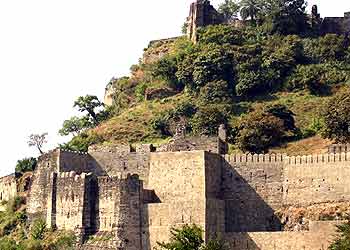Kanchipuram Travel Guide:

Introduction
Kanchipuram, Kanchi, or Kancheepuram is a temple city and a municipality in Kanchipuram district in the Indian state of Tamil Nadu. It is a temple town and the headquarters of Kanchipuram district. In ancient times it was called Kachi and Kachiampathi. Former chief minister of Tamil Nadu and founder of Dravida Munnetra Kazhagam, C.N. Annadurai was born here.
Kanchipuram is located on the Palar River, and known for its temples and silk sarees.
There are several big temples(including some of the greatest Vishnu Temples and Shiva Temples of Tamil Nadu) like Varadharaja Perumal Temple for Lord Vishnu and Ekambaranatha Temple which is one of the five forms of abodes of Lord Siva, (it is the earth abode here, other abodes include Chidambaram (Sky), Sri Kalahasti (air), Thiruvanaikaval (water) and Tiruvannamalai (fire)), Kamakshi Amman Temple, Varadharaja Perumal Temple, Kumara Kottam, Kachapeshwarar Temple, Kailasanathar Temple and many more.
Kanchipuram is also called as "City of 1000 Temples". Kanchipuram is also famous for its silk sarees, which are hand woven.
History
The term "nagareshu Kanchi" in the above verse attributed the famous Sanskrit poet, Kalidasa, means that Kanchi was the best amongst the cities of medieval India.
Kanchipuram is one of the oldest cities in South India, and was a city of learning for Tamil, Sanskrit, and Pali and was believed to be visited by Xuanzang (Huan Tsang) also known as Yuan Chwang. It was during the reign of Pallava dynasty, from the 4th to the 9th centuries that Kanchipuram attained its limelight. The city served as the Pallava capital, and many of the known temples were built during their reign. The founder of Zen Buddhism, Bodhidharma was born here, as was the famous Sanskrit writer Dandin who wrote Dashakumaracharita. The Sanskrit poet Bharavi hailed from Kanchi and wrote the famous Kiratarjuniya here under the patronage of the Pallava king Simhavishnu. Great Buddhist scholars such as Dignaga, Buddhaghosa, and Dhammapala lived here too.
The king of Kanchi, Pallava Mahendravarman I was a great scholar and musician, a man of great intelligence and also a great Sanskrit satirist and playwright.
Xuanzang, the great Chinese traveler, visited the city in the 7th century and said that this city was 6 miles in circumference and that its people were famous for bravery and piety as well as for their love of justice and veneration for learning. He further recorded that Buddha had visited the place.
As regards learning, Kanchi stood second in glory only to Banaras. The history of Kanchi can be traced back to several centuries before the advent of the Christian era. The place finds its name in Patanjali's Mahabhashya written in the 2nd century BCE Manimekalai, the famous Tamil classic, and Perumpanatru Padai, a great Tamil poetical work, vividly describe the city as it was at the beginning of the Christian era. Pattupattu, one of the sangam literatures records that the king Thondaiman Ilandirayan ruled this town around 2500 years ago.
The temple tower at a Kanchi temple
Naga-worship next to the Sri Vaigunda Perumal Temple in Kanchipuram
From the 3rd to the 9th century CE Kanchi was the capital of the Pallavas who ruled over the territory extending from the river Krishna in the north to the river Kaveri in the south. The Pallavas fortified the city with ramparts, moats, etc., with wide and well laid out roads and fine temples. They were a great maritime power with contacts with far-off China, Siam, Fiji, etc., through their chief Port Mamallapuram, the modern Mahabalipuram(now renamed again as Mamallapuram). The Cholas ruled this town from 10th century to 13th century. Kings of Vijayanagara dynasty ruled from 14th century to 17th century. The temple tower, 192 feet height in Ekamabaranadhar temple and 100-pillar mandabam (building) in Varadaraja Perumal temple in this town are famous for the architectural techniques of Vijayanagara dynasty.
Robert Clive, of the British East India Company, who played a major role in the establishment of British rule in India, is said to have presented an emerald necklace to the Varadaraja perumal (the Clive makarakandi, still used to decorate the Lord on ceremonial occasions).
Kanchi was a major seat of Tamil, Sanskrit, and Telugu learning as well as an important place of pilgrimage for Buddhists, Jains and Hindus. Once the seat of learning and religious fervour started its climb down from the Mughal invasions followed by three centuries of colonial rule under the British.
Muslim Rulers and Architecture
Kanchipuram was ruled by the Nawab of Arcot in early 1700 AD, many Mosques and Islamic Shrines are here which were built by the Nawabs. There are 9 Mosques in Kanchipuram. Nawab Sathathullah Khan Mosque and Vaikunda Perumal Temple are situated very close.
Both the mosque and the Temple share the same tank. It shows the communal harmony in Tamil Nadu and especially in Kanchipuram. The Hameed owliya dargah was also constructed by the Nawab and its a great Architecture.